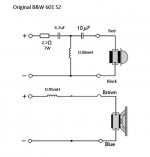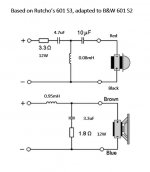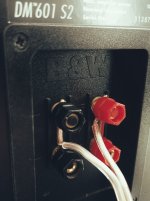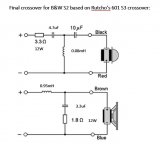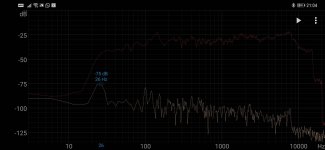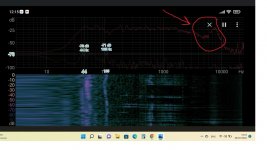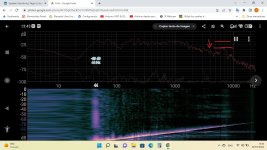Hi guys !
Recently joined this forum to read/understand more about crossovers redesign and all.
Last winter, I restored the xovers in my B&W DM640 (30 y-o!). Despite the fact that they are considered entry-level in the B&W world, they used pretty good drivers apparently and their weakest point are the xovers. So I swapped all eletrolytics for Solen polypropylene caps. I didn't like the change. I gave 'em some time to break-in, it helped a bit but still very piercing highs when listening to vinyl records (compared to lossless digital content).
Now I have to determine if I should 1- go for a complete redesign of the xovers, or 2- just tame down the tweeters with low value resistor.
Recently joined this forum to read/understand more about crossovers redesign and all.
Last winter, I restored the xovers in my B&W DM640 (30 y-o!). Despite the fact that they are considered entry-level in the B&W world, they used pretty good drivers apparently and their weakest point are the xovers. So I swapped all eletrolytics for Solen polypropylene caps. I didn't like the change. I gave 'em some time to break-in, it helped a bit but still very piercing highs when listening to vinyl records (compared to lossless digital content).
Now I have to determine if I should 1- go for a complete redesign of the xovers, or 2- just tame down the tweeters with low value resistor.
As you are starting out I'd suggest trying the resistors. Gain confidence in the process of finding the right values and notice the difference they make.
Ok, so after 6 months with the new crossovers, which are simply brilliant btw. decided to do something about the muddy upper mids. Ran loads of sine sweeps this weekend, was getting raised mids from 4kHz to around 8kHz (Ayers rock shape followed by a peak at 8/9kHz) which indicated the crossover between the two speakers wasn't ideal. Ran some circuit modelling software, played around with different values to understand the relationship of all the components.Upgrading DM601 s2 crossover
If anyone is looking to upgrade their 20 year old DM601 s2 crossovers following Rutcho's DM601 s3 instructions, here's an important note:
Do NOT reverse the tweeter's polarity. I reversed mine and found the sparkle completely gone. Turns out B&W had already reversed them (red cable was already connected to negative speaker terminal).
I upgraded my crossovers with Jantzen Standard capacitors and Mills resistors. I did look at more expensive caps but just wanted a stop-gap before buying my next set of speakers, so decided to keep it cheap. I kept the original inductors (coils) and purchased these:
2 x (RES-M1090) - 1R8 12W MRA12 Mills Resistor (1.8R) - £10.08 (£5.04 each)
2 x (RES-M1120) - 3R3 12W MRA12 Mills Resistor (3.3R) - £10.08 (£5.04 each)
2 x 001-0446: 10uF 400Vdc Jantzen Standard Z-Cap - £10.78 (£5.39 each)
2 x 001-0425: 3.3uF 400Vdc Jantzen Standard Z-Cap - £4.22 (£2.11 each)
2 x 001-0434: 4.7uF 400Vdc Jantzen Standard Z-Cap - £5.66 (£2.83 each)
Result
- The tweeters are finally tamed!! I've been listening to music for 4 hours continuously on higher volumes than usual and my ears are still not tired! The highs no longer pierce my ears whilst remaining defined and present. String instruments and cymbals have never sounded so good.
- The added LP filter (4.7uF cap and 1R8 resistor) helps bring out a LOT of detail in the mids and lows. This could also be the result of the tamed tweeters allowing me to play at louder volumes, thereby raising the presence of lows and mids to where they should be. Vocals are far far more present and forward; my jazz collection has never sounded so good.
- On the down side: upper mids/lower highs remain a little muddy. So no improvement over the original crossover. I'm hoping this will get better once the caps have burnt in with 100-300 hours of listening. This issue mostly affects loud and busy rock tracks (which isn't my style of music in the first place). Or it could simply be the quality of my recordings or the limitation of these 20 year old speakers.
Anyway, I'm really glad I completed this upgrade and would recommend anyone looking to replace their DM601 s2 because of the harsh tweeters to try this first!
Photos of the upgrade:
What I discovered is:
Using Rutcho's 3.3uF vs. B&W's 4.7uF for first capacitor in the HP filter means slightly fewer mids are getting to the tweeter.
Using Rutcho's 4.7uF in the LP filter vs. nothing in B&W's original design means highs and upper mids are cutting off more rapidly from the lower speaker.
So decided to desolder and switch around the 3.3uF and 4.7uF to get better overlap in the mids between the two speakers.
I did a side by side sound check once I switched the caps around in the first speaker, and much preferred the result. So went ahead with the second.
Result:
Voices are less muffled, more forward, upper mids are clearer, and there is slightly more soundstage (not that I like too wide a soundstage). The brightness is slightly better too, not to the original ear tiring levels! But the voices are significantly better.
Ran a sine sweep, the frequency response measured is very uniform.
So if anything, try swapping around Rutcho's 3.3 and 4.7 caps if you're upgrading your DM601s2.
Hi Alpuy, here's my current crossover for my DM 601 S2So if anything, try swapping around Rutcho's 3.3 and 4.7 caps if you're upgrading your DM601s2.""
cawauk,
Hello, interesting, but I did not quite understand the modification.
Could you post a schematic of the final configuration?
Greetings
Rutcho's upgrade had a 3.3uF cap on the High Pass, and 4.7uF on the Low Pass. I had that configuration for 6 months, enjoyed it, but mids were still muddy. So I reverted to a 4.7uF on the High Pass and 3.3uF on the Low Pass (just swap the caps if you followed Rutcho's design). This change means that the intersecting frequencies for both speakers now overlaps more, lifting up the mids. I also figured if B&W originally used 4.7uF on the HP, there was a good reason for doing so.
A good improvement on Rutcho's design for 601 S2.
Attachments
Also, a minor but surprising improvement with the upgraded crossover is to connect the + cable to the + terminal of the tweeter, the - cable up the - terminal of the bass speaker, and replace the flat links with cable. See photo.Hi Alpuy, here's my current crossover for my DM 601 S2
Rutcho's upgrade had a 3.3uF cap on the High Pass, and 4.7uF on the Low Pass. I had that configuration for 6 months, enjoyed it, but mids were still muddy. So I reverted to a 4.7uF on the High Pass and 3.3uF on the Low Pass (just swap the caps if you followed Rutcho's design). This change means that the intersecting frequencies for both speakers now overlaps more, lifting up the mids. I also figured if B&W originally used 4.7uF on the HP, there was a good reason for doing so.
A good improvement on Rutcho's design for 601 S2.
Note that this config was not enjoyable when I tried it prior to the crossover upgrade - the tweeters were just too piercing with the cables connected this way.
Attachments
Cable vs. flat link? Probably not much, something I read a while ago, about the materials used for this range of speakers not being the best, and that swapping the links out with good quality cable was a better option. Never did an A/B test. The flat links however once removed did seem pretty cheap. Gold coated steel or aluminium or something like that, very lightweight too.How is this different to the flat links?
As for + into tweeter and - into mid range, I read it online, something about impedance, path to least resistance, and that it was better to feed high frequencies first. Honestly I didn't think it would make a difference until I tried it, and it did give these B&W tweeters more power. However prior to Rutcho's upgraded crossover, more power to the tweeters wasn't bearable.
After several experiments this weekend followed by listening tests (swapping around capacitors, adding expensive bypass capacitors, and reversing tweeter polarity) I've come to the following conclusion for the DM601s2:So if anything, try swapping around Rutcho's 3.3 and 4.7 caps if you're upgrading your DM601s2.""
cawauk,
Hello, interesting, but I did not quite understand the modification.
Could you post a schematic of the final configuration?
Greetings
- my 4.7uF <> 3.3uF reversal vs. Rutcho's mods is indeed better for the S2s
- reversing tweeter polarity as per Rutcho's mods is indeed better (for some reason I didn't like it originally when I had the 3.3uF capacitor on the high pass, but now that I have reversed it, and with the 4.7uF on the high pass, it has definitely cleaned up the upper mids/lower highs, plus there is no longer a small dip around the 4-5kHz mark)
- the 3.3Ω resistor could be swapped out for a 3.5Ω or 3.9Ω to bring down the highs ever so slightly and give these wonderful speakers a slightly warmer tone.
- bypassing with Miflex 0.022uF paper oil caps just doesn't work (not to my taste), even after 3 days of burn in. With the caps, everything sounds spacial, yes you get increased clarity of highs but they are projected out in front of voices losing a tight silky cohesion to music, with increased lightness and mild echo to singers' voices. Plus, this lightness does not exist on my B&W P7s and Sony WF-1000x3 headphones, so bypassing I think creates a reverb in the highs which I just don't like, especially with the DM601S2's metal dome tweeters. It doesn't work to my taste, especially not with warm live jazz music.
Final recommended diagram attached and a (unscientific) frequency response measured with my phone 50cm from the speaker.
Attachments
Cawauk, could you tell me how you have achieved that frequency response graph with the telephone?
Pink noise in the amp? What APP?
Pink noise in the amp? What APP?
I use "spectroid" app and play a frequency sweep from YouTube. Now obviously this is hardly scientific, as:Cawauk, could you tell me how you have achieved that frequency response graph with the telephone?
Pink noise in the amp? What APP?
a) the frequency sweep recording quality is unknown
b) I have no idea how accurate the microphone on my phone is (note the HF drop, this happens across all amplifier/speaker tests so likely due to phone mic limitations)
c) I live on the last floor with sloping roof and a huge kitchen counter separating living room from kitchen, resulting in numerous room modes (especially around lower frequencies which can easily be heard moving around)
d) my measurements were made with speakers in their listening positions, i.e. less than 1m from the wall.
However, this approach is helpful for before and after comparisons using different crossover configurations. For example, I've attached the sweep result prior to reversing my tweeter connections - you can clearly see the 4kHz to 5kHz dip.
Attachments
I have 603 s3. What crossover mods would you suggest? I've already upgraded the internal box cabling with qed speaker cable.
IIRC the 603 has the same mid and tweeter as the 601. So you could make the original upgrade to them.I have 603 s3. What crossover mods would you suggest? I've already upgraded the internal box cabling with qed speaker cable.
With the bass driver LPF and mid driver HPF I don't really know. You'd have to measure a frequency sweep with a measuring microphone and then design the crossover based on that, IF the original isn't good enough.
Hello. I have installed a 0.33 uF capacitor in parallel with the 1.2mH bass inductor in order to reduce the cone breakdown of the midwoofer that is apparently at 7.5khz (notch filter). I clarify that I am talking about the addition of the capacitor in the original crossover.
I made some non-professional measurements with REW scanning and captured with the mobile phone with APP Spectroid. tweeter not connected.
I made some non-professional measurements with REW scanning and captured with the mobile phone with APP Spectroid. tweeter not connected.
Attachments
ALPUY, could you please provide a diagram of a modified crossover for your B&W 602 ver.1. I have the same speakers and I want to modify them to get a slightly better sound.
Hello Ratalo. It has always seemed to me that these speakers (B&W DM602 version 1) are fatiguing in prolonged listening because they have an increase in their treble response.
I have tried all the tips mentioned in this post.
At first I thought the changes were good, but after a while I see that I don't like it anymore and I've gone back to the original crossover.
Until I read somewhere that some speaker cones have what is called cone breakage, an increase in intensity generally around 5-10khz.
It occurred to me to unprofessionally measure the response of the midwoofer without the tweeters being connected and it gave me a peak intensity of a few dB at 7.5Khz. it's probably that spike that was causing those annoying highs.
With a crossover simulator (Xsim) I found the right capacitor to put in parallel with the woofer inductor to form a notch filter at that specific frequency.
The result is that listening to you is more pleasant without losing definition in the treble.
I have shown the graphs previously.
Greetings.
I have tried all the tips mentioned in this post.
At first I thought the changes were good, but after a while I see that I don't like it anymore and I've gone back to the original crossover.
Until I read somewhere that some speaker cones have what is called cone breakage, an increase in intensity generally around 5-10khz.
It occurred to me to unprofessionally measure the response of the midwoofer without the tweeters being connected and it gave me a peak intensity of a few dB at 7.5Khz. it's probably that spike that was causing those annoying highs.
With a crossover simulator (Xsim) I found the right capacitor to put in parallel with the woofer inductor to form a notch filter at that specific frequency.
The result is that listening to you is more pleasant without losing definition in the treble.
I have shown the graphs previously.
Greetings.
I know this is an older post, but I am very new to all of this and trying to learn as much as I can, but with everyone posting different variations it’s got me so confused. Could you give me a shopping list of what I need to mod my 602 S2 crossovers and post a pic or two of your end result? I would appreciate so much.Sign in to your account
IIrc, this is the final crossover I came up with. You can go and compare it to the dm602 upgrade and B&W official repair manual's crossover.
It is a little messy but this was my first time modelling crossovers.
Just remember to use air-core inductors, film caps and at least not-basic resistors.
In my opinion the dm602 would be a better speaker to upgrade because they have more bass extension and they look a lot better (if in good shape), but the older model might as well sound just as good with a good crossover.
I went with the cheap route using most of the original parts and the cost was not much, but upgrading everything might be worth it.
If you go and see GR-Research on youtube, you will realize that close to none of the well known speaker manufacturers, like Klipsch, have good enough crossovers and flat responses. So upgrading a cheaper pair with good drivers might be the way to go.
IIrc he had a video of the upgrade for the RP600M and he has an upgrade-kit on his website for it.
- Home
- Loudspeakers
- Multi-Way
- B&W DM602 s3 crossover mod
